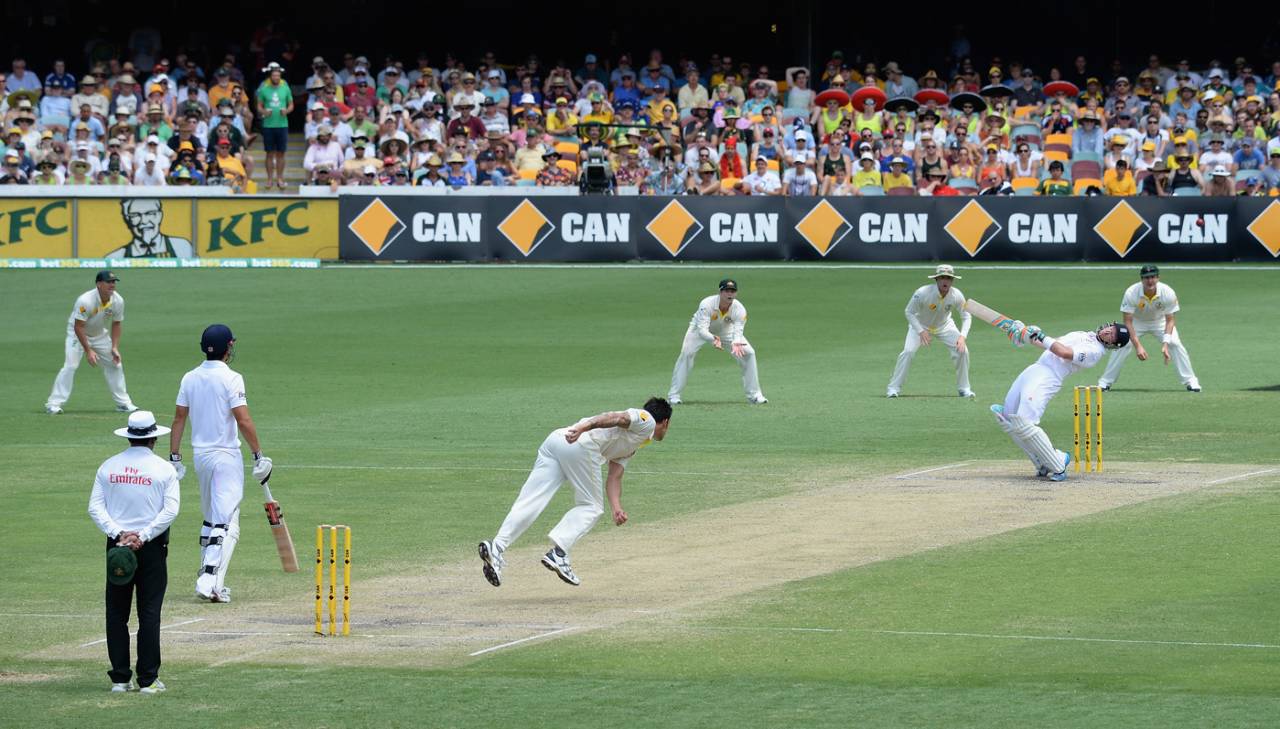How important is hostility?
Australian cricket jealously protects the right to intimidate. It's who we are, we've always been this way, and we're proud of it
Sam Perry
17-Oct-2016

There was a visceral thrill in watching England batsmen fear Mitchell Johnson's bowling in the 2013-14 Ashes. Why is that? • Getty Images
Can anybody truly say they thrive as the target of social and physical hostility? In any of life's myriad endeavours, competitive or otherwise, success is usually achieved in spite of hostility, not because of it.
So the logic goes in much of Australian cricket. While the battle is officially between bat and ball, there is an unofficial social dimension to combat too. And while we only whispered it softly last week, our time-honoured tradition of creating cold, hostile atmospheres for batsmen is otherwise a matter of chest-thumping pride. A welcome batsman is a sleeping batsman, because that scenario is the stuff of dreams.
In a week where public introspection threatened but never quite manifested, it wasn't just at home that our cricketing philosophy was under the microscope. Earlier in the week, Kepler Wessels, the former South Africa captain who also played for Australia, derided the "embarrassing" and "totally ineffective" sledging of the Australian players as they eventually slumped to a 5-0 whitewash against South Africa.
Speaking on the same issue 24 hours later, in-vogue Australian batting coach Trent Woodhill said, "We need to get away from this mentality of 'we've all played the game, you've got to be tougher, you've got to be harder, you've got be noisier, you've got to be louder', because it's basically bullshit."
In an increasingly saturated game, where contests feel automated and matches blend into one another, Woodhill's point, sacrilegious as it is, has the ring of truth. But can Australians divorce themselves from their deep-seated cultural attachment to noise and hardness?
The court of public opinion reached its decision quickly and emphatically: "This was a freak accident." "No one is to blame." "Sledging and intimidation are part of the game." "Only harm can come from this"
Perhaps more important is whether we'd even be willing to. Hostility is celebrated in our cricketing culture, and those who can demonstrate it best are revered for it, in the main. The views of Wessels and Woodhill swim against an Australian tide that protects the divine right to intimidate like fanatical Americans do their guns. It's who we are, we've always been this way, and we're proud of it. Despite Woodhill's argument that it's not even advantageous to winning, one feels that any attempt to change those attitudes would be regarded as "soft", and as a result, unthinkable.
If we were willing to engage in some introspection, our view of bouncers may be a good place to start. Let's be honest about them: beyond the odd occasion where they are legitimately deployed as a defensive tactic against rampant batsmen, bouncers in cricket are like fights in footy. For most, there is a visceral pleasure in watching seasoned athletes put every part of their bodies at risk for sporting success. Or when it comes to fights, some kind of masculine honour. We know it's wrong but it feels so right.
Australians watched Mitchell Johnson against England in 2013 with an almost primal satisfaction. The blood-curdling fear of the English batsmen released a spiritual type of pleasure, because this was as Aussie as Aussie could get. But it's worth asking: are there any other ball sports that legally permit opposition engagement with the head? Even in that sport notorious for attacking the head, rugby league, the laws at least attempt to prevent it.
To ask questions of our relationship to hostile cricket isn't to call for radical change, if any. But our automatic dismissal of the mere possibility that there might be something to learn from this week's conversations, both home and abroad, says more about us than the event itself.

While it's understandable that the public will sympathise with the players, it's not right to reject discussing the subjects of hostility and intimidation without giving them due consideration•Getty Images
The cricket world watched as the NSW Coroner's Court held an inquest into Phillip Hughes' death. Concerned about unfair blame and the creation of witch hunts, the Australian public rallied behind the players involved, understandably so. While the court pondered the events of the day, the court of public opinion reached its decision quickly and emphatically: "This was a freak accident." "No one is to blame." "Sledging and intimidation are part of the game." "Only harm can come from this," we chorused.
While there may be something darkly instructive about the certitude of our response, it is - more than anything - a raw expression of sympathy for the players involved. But there were some uncomfortable truths at play too, and the almost knee-jerk refusal to engage in collective reflection about what happened on the field that day is revealing.
Because if ever there was an event significant enough to warrant simple introspection about the way we play cricket in Australia, then surely this was it.
Of course, nobody wanted what happened at the SCG to happen, and blame is not the point; that's undisputed. But there is a sense that we have missed an opportunity to think with some depth about the impact of Hughes' death on our cricketing philosophy.
Because while the inquest was importantly about a young man's life and the moments before and after the incident, the examination may have initiated important contemplation about the game more broadly. The main questions may have become: How important is hostile cricket to us? How proud of our intimidatory approach should we really be?
If, like most, your conclusion is "very", then that's fine. The important part is that the question was considered at all.
Sam Perry is a Melbourne-based sportswriter @sjjperry